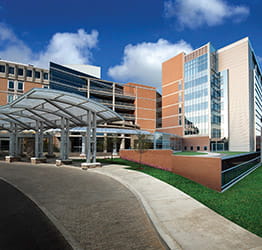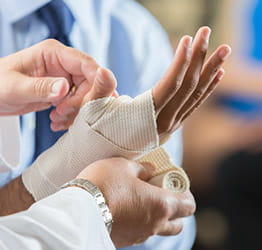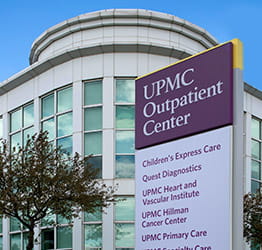Spinal stenosis is a condition characterized by the narrowing of your spinal canal, the small passage that houses your spinal cord and nerve roots. As this space narrows, it can compress your nerves and spinal cord, causing pain, mobility challenges, and other debilitating symptoms.
Spinal stenosis most commonly occurs in the cervical (neck) and lumbar (lower back) regions of the spine. Treatment options vary based on the severity of your condition, and may include medication, physical therapy, supportive devices, or spinal surgery.
On this page
What Is Spinal Stenosis?
Spinal stenosis occurs when your spinal canal becomes compressed or narrowed, putting pressure on your nerves and spinal cord. This condition often develops gradually over time and is most frequently found in the cervical (neck) or lumbar (lower back) regions of your spine.
Your spinal canal is the hollow space within each vertebra (spinal bone) that surrounds your spinal cord and nerve roots. Your spinal cord is a vital structure that extends from the base of your brain down through your spine, with nerve roots branching out to different parts of your body. When these nerves are compressed, it can cause significant pain and discomfort, particularly in your legs and lower back.
Although some people with spinal stenosis may never experience symptoms, others may develop chronic pain and mobility issues that require medical intervention.
What causes spinal stenosis?
Spinal stenosis can be caused by several factors, with aging being the most common cause. As you age, structural changes occur in your spine, such as:
- Development of bone spurs that protrude into your spinal canal.
- Enlargement of bones and joints, narrowing your spinal canal.
- Thickened and calcified (hardened) ligaments.
Other causes include:
- Congenital spinal stenosis — Some people are born with a naturally narrow spinal canal.
- Spinal deformities — Conditions such as scoliosis (curved spine) and achondroplasia (a form of dwarfism) increase your risk of spinal stenosis.
What are spinal stenosis risk factors and complications?
Spinal stenosis risk factors
Although spinal stenosis can affect anyone, the risk increases with age. Additional risk factors include:
- Congenital narrowed spinal canal.
- Medical conditions, such as:
- Spinal injuries or trauma.
Spinal stenosis complications
If left untreated, spinal stenosis can lead to severe and debilitating symptoms, including chronic pain, difficulty walking, and loss of bladder or bowel control in extreme cases.
How can I reduce my risks of spinal stenosis?
Research suggests that up to 90 percent of people will experience back pain at some point in their lives. Although spinal stenosis cannot always be prevented, certain lifestyle choices may help reduce your risk. Lifestyle changes include:
- Avoiding smoking.
- Keeping a moderate weight.
- Maintaining a healthy diet.
- Practicing good posture.
- Regular exercise and core strengthening.
How common is spinal stenosis?
Spinal stenosis is relatively common, but more than 80 percent of people with the condition never experience symptoms. Although back pain is widespread in the U.S., not everyone with back pain has cervical or lumbar spinal stenosis.
Back to top
What Are the Signs and Symptoms of Spinal Stenosis?
Symptoms of spinal stenosis typically develop gradually and vary based on the location of the spinal narrowing.
Lumbar spinal stenosis symptoms
- Achy or burning pain in your lower back that radiates into your buttocks and legs.
- Leg pain that worsens when standing or walking but improves when bending forward.
- Numbness, cramping, or weakness in your legs and feet.
- Weakness in your lower extremities.
Cervical spinal stenosis symptoms
- Neck pain that improves when bending forward.
- Numbness, tingling, or cramping that radiates down your arms.
- Weakness in your hands, fingers, or arms.
Severe spinal stenosis symptoms that require immediate medical attention
- Loss of bladder or bowel control.
- Partial or complete paralysis of your legs.
- Sexual dysfunction.
When should I see a doctor about my spinal stenosis symptoms?
If symptoms persist for more than a few weeks, become worse, or are severe, consult your health care provider.
Back to top
How Do You Diagnose Spinal Stenosis?
Doctors diagnose spinal stenosis by reviewing your medical history and conducting a physical exam. They assess pain location, strength, movement, reflexes, and nerve function. Additional diagnostic tests may include:
- CT scan — Offers cross-sectional views of your spine.
- Electromyography (EMG) — Tests nerve function.
- MRI — Provides detailed images of soft tissues and nerves.
- X-ray — Identifies bone abnormalities, such as osteoarthritis and bone spurs.
Back to top
How Do You Treat Spinal Stenosis?
Treatment for spinal stenosis varies based on the severity of your condition. Doctors often begin with conservative, noninvasive treatments before considering surgery.
Lifestyle modifications
Lifestyle modifications include:
- Bending forward to relieve pressure on your spine.
- Maintaining a healthy lifestyle through diet and exercise.
- Taking breaks and stretching when standing or walking.
Nonsurgical treatments
Doctors may recommend a combination of pain medication and physical therapy to alleviate symptoms. Many people experience relief within 1-2 months of starting conservative treatment.
Medications may include:
- Analgesics (pain relievers).
- Antidepressants (for chronic pain management).
- Anti-seizure drugs (to control nerve pain).
- Cortisone injections (to reduce inflammation).
- Nonsteroidal anti-inflammatory drugs (NSAIDs).
- Opioids (for short-term use to treat severe pain).
Physical therapy for spinal stenosis may include:
- Balance and flexibility training.
- Pain management techniques.
- Strengthening and endurance-building exercises.
- Wearing a lumbar brace for additional support.
Surgical treatment for spinal stenosis
If conservative treatments do not provide relief, surgery may be necessary. Surgical treatment options may include:
- Decompression laminectomy — Surgeons remove bone spurs and excess bone to create more space for your nerves.
- Spinal fusion — Often performed after a laminectomy, two vertebrae (back bones) are fused to stabilize your spine.
Recovery from spinal stenosis surgery
Recovery times vary, but most patients experience improved mobility and pain relief with proper postoperative care and rehabilitation.
Back to top
Why Choose UPMC for Spinal Stenosis Care?
UPMC surgeons use the least invasive, most effective approach to treat all types of spinal disorders. Our team has pioneered some of the latest approaches to spinal stenosis care using advanced techniques — promoting enhanced treatment, outcomes, and quality of life.
By UPMC Editorial Staff. Last reviewed on 2025-05-16.
















